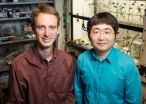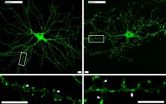(Press-News.org) Scientists have developed what they believe is the thinnest-possible semiconductor, a new class of nanoscale materials made in sheets only three atoms thick.
The University of Washington researchers have demonstrated that two of these single-layer semiconductor materials can be connected in an atomically seamless fashion known as a heterojunction. This result could be the basis for next-generation flexible and transparent computing, better light-emitting diodes, or LEDs, and solar technologies.
"Heterojunctions are fundamental elements of electronic and photonic devices," said senior author Xiaodong Xu, a UW assistant professor of materials science and engineering and of physics. "Our experimental demonstration of such junctions between two-dimensional materials should enable new kinds of transistors, LEDs, nanolasers, and solar cells to be developed for highly integrated electronic and optical circuits within a single atomic plane."
The research was published online this week in Nature Materials.
The researchers discovered that two flat semiconductor materials can be connected edge-to-edge with crystalline perfection. They worked with two single-layer, or monolayer, materials – molybdenum diselenide and tungsten diselenide – that have very similar structures, which was key to creating the composite two-dimensional semiconductor.
Collaborators from the electron microscopy center at the University of Warwick in England found that all the atoms in both materials formed a single honeycomb lattice structure, without any distortions or discontinuities. This provides the strongest possible link between two single-layer materials, necessary for flexible devices. Within the same family of materials it is feasible that researchers could bond other pairs together in the same way.
The researchers created the junctions in a small furnace at the UW. First, they inserted a powder mixture of the two materials into a chamber heated to 900 degrees Celsius (1,652 F). Hydrogen gas was then passed through the chamber and the evaporated atoms from one of the materials were carried toward a cooler region of the tube and deposited as single-layer crystals in the shape of triangles.
After a while, evaporated atoms from the second material then attached to the edges of the triangle to create a seamless semiconducting heterojunction.
"This is a scalable technique," said Sanfeng Wu, a UW doctoral student in physics and one of the lead authors. "Because the materials have different properties, they evaporate and separate at different times automatically. The second material forms around the first triangle that just previously formed. That's why these lattices are so beautifully connected."
With a larger furnace, it would be possible to mass-produce sheets of these semiconductor heterostructures, the researchers said. On a small scale, it takes about five minutes to grow the crystals, with up to two hours of heating and cooling time.
"We are very excited about the new science and engineering opportunities provided by these novel structures," said senior author David Cobden, a UW professor of physics. "In the future, combinations of two-dimensional materials may be integrated together in this way to form all kinds of interesting electronic structures such as in-plane quantum wells and quantum wires, superlattices, fully functioning transistors, and even complete electronic circuits."
The researchers have already demonstrated that the junction interacts with light much more strongly than the rest of the monolayer, which is encouraging for optoelectric and photonic applications like solar cells.
INFORMATION:
Other co-authors are Chunming Huang and Pasqual Rivera of UW physics; Ana Sanchez, Richard Beanland and Jonathan Peters at the University of Warwick; Jason Ross of UW materials science and engineering; and Wang Yao, a theoretical physicist of the University of Hong Kong.
This research was funded by the U.S. Department of Energy, the UW's Clean Energy Institute, the Research Grant Council of Hong Kong, the University Grants Committee of Hong Kong, the Croucher Foundation, the Science City Research Alliance and the Higher Education Funding Council for England's Strategic Development Fund.
For more information, contact Wu at swu02@uw.edu.
Grant numbers: U.S. Department of Energy, Basic Energy Sciences, Materials Sciences and Engineering Division (DE-SC0008145) (DE-SC0002197).
Nature Materials paper: http://www.nature.com/nmat/journal/vaop/ncurrent/full/nmat4064.html END
Scientists craft atomically seamless, thinnest-possible semiconductor junctions
2014-08-26
ELSE PRESS RELEASES FROM THIS DATE:
Personal protective equipment is critical but not enough to shield health care workers from Ebola
2014-08-26
Personal protective equipment is critical but not enough to shield health care workers from Ebola*
Free content
Personal protective equipment designed to shield health care workers from contaminated body fluids of Ebola patients is not enough to prevent transmission, according to a commentary being published early online today in Annals of Internal Medicine. Despite the known effectiveness of barrier protection in blocking Ebola transmission, infections among health care workers have played a major role in outbreaks. William A. Fischer II, MD from the University of North ...
Challenges ahead in improving child health by increasing access to sanitation in India
2014-08-26
A study published in this week's PLOS Medicine on large-scale rural sanitation programs in India highlights challenges in achieving sufficient access to latrines and reduction in open defecation to yield significant health benefits for young children.
The researchers, led by Sumeet Patil from the School of Public Health, University of California at Berkeley, and the Network for Engineering and Economics Research and Management in Mumbai, India conducted a cluster randomised controlled trial in 80 rural villages in the Indian state of Madhya Pradesh to measure the effect ...
A glucose meter of a different color provides continuous monitoring
2014-08-26
CHAMPAIGN, Ill. — University of Illinois engineers are bringing a touch of color to glucose monitoring.
The researchers developed a new continuous glucose monitoring material that changes color as glucose levels fluctuate, and the wavelength shift is so precise that doctors and patients may be able to use it for automatic insulin dosing - something not possible using current point measurements like test strips.
"There are significant limitations to current continuous glucose monitoring technologies," said study leader Paul Braun, a professor of materials science and ...
NASA's TRMM and Aqua satellites gaze into Hurricane Cristobal
2014-08-26
NASA's TRMM and Aqua satellites have been providing views of the outside and inside of Hurricane Cristobal as it heads for Bermuda. The National Hurricane Center posted a Tropical Storm Watch for Bermuda as Cristobal heads in that direction.
Strong winds and flooding associated with Tropical Storm Cristobal caused deaths in the Dominican Republic, Haiti, and Jamaica. The Tropical Rainfall Measuring Mission or TRMM satellite captured rainfall data from Cristobal on August 24, 2014 at 1150Z (7:50 a.m. EDT). Light to moderate rainfall was occurring throughout much of the ...
Satellite shows Hurricane Marie about to swallow Karina
2014-08-26
Massive Hurricane Marie appears like a giant fish about to swallow tiny Tropical Depression Karina on satellite imagery today from NOAA's GOES-West satellite. Karina, now a tropical depression is being swept into Marie's circulation where it is expected to be eaten, or absorbed.
An image from NOAA's GOES-West satellite on Aug. 26 at 8 a.m. EDT shows Karina being drawn into the powerful and large circulation of Hurricane Marie to the east of the depression. The image was created by NASA/NOAA's GOES Project at NASA's Goddard Space Flight Center in Greenbelt, Maryland.
Forecasters ...
NASA sees huge Hurricane Marie slam Socorro Island
2014-08-26
NASA's Terra satellite passed over Hurricane Marie when its eye was just to the west of Socorro Island in the Eastern Pacific. Marie's eye may have been near the island, but the storm extended several hundreds of miles from there.
On Aug. 25 at 18:20 UTC (2:20 p.m. EDT) the Moderate Resolution Imaging Spectroradiometer or MODIS instrument aboard NASA's Terra satellite captured Hurricane Marie's center just west of Socorro Island. The image showed Marie's tightly wound center and eye. A thick band of powerful thunderstorms surrounded the center of circulation, and bands ...
Lack of naturally occuring protein linked to dementia
2014-08-26
Scientists at the University of Warwick have provided the first evidence that the lack of a naturally occurring protein is linked to early signs of dementia.
Published in Nature Communications, the research found that the absence of the protein MK2/3 promotes structural and physiological changes to cells in the nervous system. These changes were shown to have a significant correlation with early signs of dementia, including restricted learning and memory formation capabilities.
An absence of MK2/3, in spite of the brain cells (neurons) having significant structural ...
Existing power plants will spew 300 billion more tons of carbon dioxide during use
2014-08-26
Irvine, Calif. — Existing power plants around the world will pump out more than 300 billion tons of carbon dioxide over their expected lifetimes, significantly adding to atmospheric levels of the climate-warming gas, according to UC Irvine and Princeton University scientists.
Their findings, which appear Aug. 26 in the journal Environmental Research Letters, are the first to quantify how quickly these "committed" emissions are growing – by about 4 percent per year – as more fossil fuel-burning power plants are built.
Assuming these stations will operate for 40 years, ...
Brain benefits from weight loss following bariatric surgery
2014-08-26
Washington, DC—Weight loss surgery can curb alterations in brain activity associated with obesity and improve cognitive function involved in planning, strategizing and organizing, according to a new study published in the Endocrine Society's Journal of Clinical Endocrinology & Metabolism (JCEM).
Obesity can tax the brain as well as other organs. Obese individuals face a 35 percent higher risk of developing Alzheimer's disease compared to normal weight people.
Bariatric surgery is used to help people who are dangerously obese lose weight. Bariatric surgery procedures ...
Coal's continued dominance must be made more vivid in climate change accounting
2014-08-26
The world's accounting system for carbon emissions, run by the United Nations, disregards capital investments in future coal-fired and natural-gas power plants that will commit the world to several decades and billions of tons of greenhouse gas emissions, according to a new study from Princeton University and the University of California-Irvine published Aug. 26 in the journal Environmental Research Letters.
In the paper, Robert Socolow, a Princeton professor, emeritus, of mechanical and aerospace engineering, and co-author Steven Davis, a professor of earth system science ...








